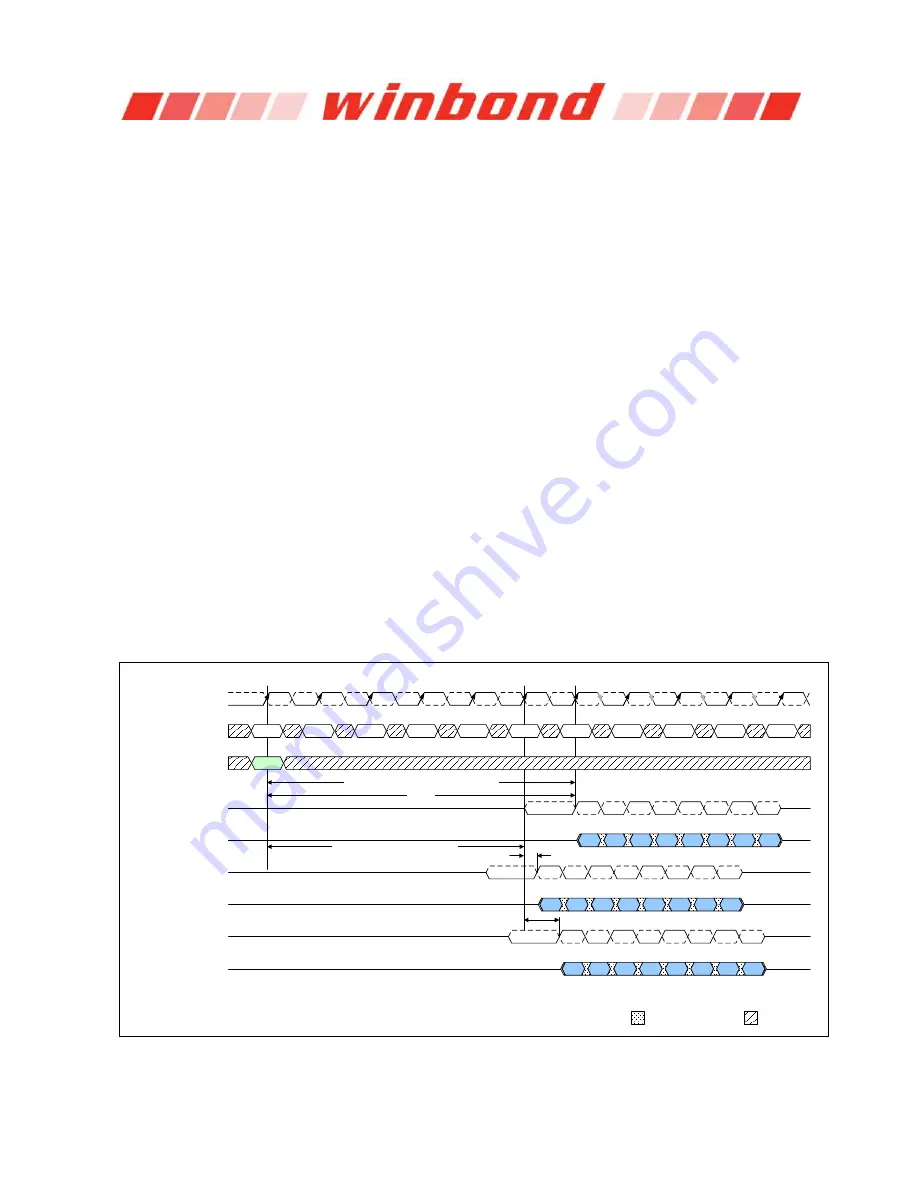
W632GU6NB
Publication Release Date: Aug. 20, 2018
Revision: A01
- 26 -
8.4 No OPeration (NOP) Command
The No OPeration (NOP) command is used to instruct the selected DDR3L SDRAM to perform a NOP
(CS# LOW and RAS#, CAS#, and WE# HIGH). This prevents unwanted commands from being
registered during idle or wait states. Operations already in progress are not affected.
8.5 Deselect Command
The DESELECT function (CS# HIGH) prevents new commands from being executed by the DDR3L
SDRAM. The DDR3L SDRAM is effectively deselected. Operations already in progress are not
affected.
8.6 DLL-off Mode
DDR3L DLL-
off mode is entered by setting MR1 bit A0 to “1”; this will disable the DLL for subsequent
operations until A0 bit is set back to “0”. The MR1 A0 bit for DLL control can be switched either during
initialization or later. Refer to section 8.8
“Input clock frequency change”
on page 29.
The DLL-off Mode operations listed below are an optional feature for DDR3L. The maximum clock
frequency for DLL-off Mode is specified by the parameter t
CK(DLL_OFF)
. There is no minimum
frequency limit besides the need to satisfy the refresh interval, t
REFI
.
Due to latency counter and timing restrictions, only one value of CAS Latency (CL) in MR0 and CAS
Write Latency (CWL) in MR2 are supported. The DLL-off mode is only required to support setting of
both CL=6 and CWL=6.
DLL-off mode will affect the Read data Clock to Data Strobe relationship (t
DQSCK
), but not the Data
Strobe to Data relationship (t
DQSQ
, t
QH
). Special attention is needed to line up Read data to controller
time domain.
Comparing with DLL-on mode, where t
DQSCK
starts from the rising clock edge (AL+CL) cycles after
the Read command, the DLL-off mode t
DQSCK
starts (AL+CL - 1) cycles after the read command.
Another difference is that t
DQSCK
may not be small compared to t
CK
(it might even be larger than t
CK
)
and the difference between t
DQSCK
min and t
DQSCK
max is significantly larger than in DLL-on mode.
The timing relations on DLL-off mode READ operation is shown in the following Timing Diagram
(CL=6, BL=8):
TRANSITIONING DATA
T0
T1
T2
T3
T4
T5
T6
T7
T8
T9
T10
CK#
CK
Command
READ
Address
NOP
NOP
NOP
NOP
NOP
NOP
NOP
NOP
NOP
NOP
Bank
Col b
DON'T CARE
DQS,DQS# (DLL_on)
DQ (DLL_on)
DQS,DQS# (DLL_off)
DQ (DLL_off)
DQS,DQS# (DLL_off)
DQ (DLL_off)
RL (DLL_on) = AL + CL = 6 (CL = 6, AL = 0)
CL = 6
RL (DLL_off) = AL + ( CL
– 1 ) = 5
t
DQSCK
(
DLL
_off)_min
t
DQSCK
(
DLL
_on)_max
Dout
b
Dout
b+1
Dout
b+2
Dout
b+3
Dout
b+4
Dout
b+5
Dout
b+6
Dout
b+7
Dout
b
Dout
b+1
Dout
b+2
Dout
b+3
Dout
b+4
Dout
b+5
Dout
b+6
Dout
b+7
Dout
b
Dout
b+1
Dout
b+2
Dout
b+3
Dout
b+4
Dout
b+5
Dout
b+6
Dout
b+7
Note:
The tDQSCK is used here for DQS, DQS# and DQ to have a simplified;
the DLL_off shift will affect both timings in the same way and the skew
between all DQ, and DQS, DQS# signals will still be tDQSQ.
Figure 9
– DLL-off mode READ Timing Operation
















































